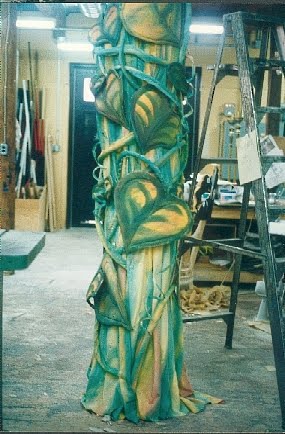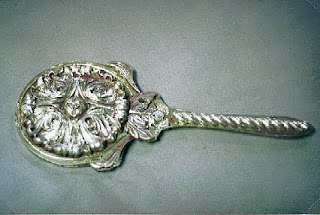Canadian Stage Company
The beanstalk for Into the Woods had to collapse into a hole in the stage and “grow” during the show.
Jules Tonus painted the fabric, which conceals the armature, before we started building the set piece.
To construct it, we worked from a blueprint drawing. The prop shop at Canadian stage was an old stable, so there was a trap door in the ceiling. We strung it up on a winch so we could work on the upper level in the old loft and also down in the main workshop.
We measured and cut large discs of wood from plywood on the band saw and screwed them to the table in the workshop to use them as armatures. I made giant hoops of plastic by using a heat gun to shape plastic rods about half an inch in diameter around the disks. Each piece of plastic overlapped by a few inches and I drilled holes to thread wire through and joined them together.
I then strung the hoops, which got successively smaller toward the top of the beanstalk, together with window sash cord using simple hitch knots. In this case, the blueprint drawing was not very good. The angles of the hoops in the drawing were impossible to match, but I had to prove it.
Initially, I tried to match the drawing, then realized it wouldn’t work, so I did it a new way, but the designers thought I had not followed the drawing, so I had to redo it wrong, so that they could see it didn’t work. Then I had to redo it again.
This is the back of a mirror. Into the Woods was done in baroque style, I cut a shape out of lexan plastic on the bandsaw and then stuck bits and pieces of wood and plastic onto it. I painted it a rust colour first and then gold, leaving the red hue showing through to give the object greater depth and richness. I used gold leaf to create another range of highlights. It is about 14 inches long. The other side had a mirror on it.
Unfortunately, I took the picture of the black scissors on a white background so they are difficult to see. They are also over-sized and made of Lexan (bulletproof) plastic. I modeled them on real scissors, so they had a hinge made with a nut and bolt. I stripped the bolt (filed it smooth) so the scissors could “snip” freely.











